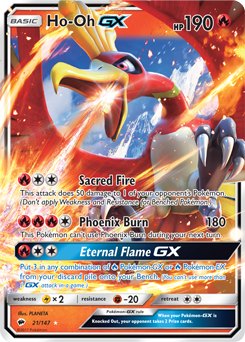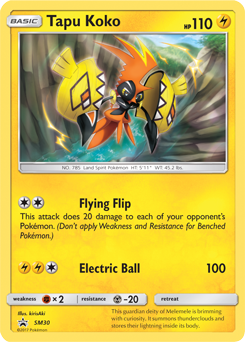Fire in the Sky — Ho-Oh-GX / Salazzle-GX in the New Standard Format
Hello! I’m Stéphane Ivanoff and you may know me as the winner of the 2018 North American International Championship. I’ve been playing the Pokemon TCG since 2010 and, although my most prestigious accomplishment was recent, I’ve had success in the European competitive scene for years, including two National Championship wins. I’ve spent a lot of time thinking and writing about the game, and I’m excited to share my expertise with an English-speaking audience for the first time.
 As PokeBeach’s resident European, you might expect me to write about European decks, also known as Zoroark-GX decks — seriously, almost every top European player has played a Zoroark deck at an International Championship or Worlds last year! And although I’m sure I’ll do so at some point, I’ve actually started the season by testing non-Zoroark decks. With the loss of Brigette and Puzzle of Time, Zoroark decks have lost a non-negligible amount of consistency, and I used that opportunity to explore other options.
As PokeBeach’s resident European, you might expect me to write about European decks, also known as Zoroark-GX decks — seriously, almost every top European player has played a Zoroark deck at an International Championship or Worlds last year! And although I’m sure I’ll do so at some point, I’ve actually started the season by testing non-Zoroark decks. With the loss of Brigette and Puzzle of Time, Zoroark decks have lost a non-negligible amount of consistency, and I used that opportunity to explore other options.
Among these other options, the deck I’ve enjoyed the most so far is Ho-Oh-GX / Salazzle-GX, a deck I already found success with last season when I used it to reach Top 8 at Malmö Regionals.
I’d like to make it clear up front that this is not the secret BDIF that will dominate the game. Rather, it is a meta-dependent deck that can struggle with Energy acceleration decks like Malamar, but destroys Metagross-GX, is favored against Zoroark decks and deals pretty well with many rogue decks, such as Beast Box, Solgaleo-GX, Silvally-GX, etc. In the appropriate metagame, Ho-Oh / Salazzle could be your ticket to a League Cup win or a successful Regional run. As for me, it’s a deck I’m considering playing at Frankfurt Regionals (29-30 September) since I expect many top European players to bring a Zoroark variant. An underrated benefit of the deck in a best-of-three tournament is that because its games are so fast, you’ll mostly avoid ties.
In this article, I’d like to discuss what makes a deck good in the new format and explain what makes Ho-Oh worth playing. I’ll give a list, some tech options, explain all you need to know in order to play the deck to its best potential including how to approach various matchups, and even discuss the deck’s future. Sounds good? Let’s go.
Ho-Oh and the New Format
The new Sun & Moon-on format is upon us, and as I’m sure you’ve noticed, it brings a variety of changes. For the first time since 2011, we don’t have Professor Sycamore or Professor Juniper in the format. We also lost N, which has stayed in Standard for almost as long; and Brigette, which was the main way Evolution decks such as Zoroark or Malamar would set up. Despite that, Evolution decks seem to be thriving. Vikavolt and Metagross-GX seem to do well so far, as does Malamar, with other Stage 2 decks like Magnezone seeing some results as well. How is it possible that losing consistency cards would make Stage 2 decks, those whose consistency is the shakiest, better than they used to be? There are a few explanations:
First, Professor Sycamore wasn’t that beneficial to Stage 2 decks. Since 2011, discard-and-draw-seven Supporters have mostly enabled decks relying on Basic Pokemon to go even faster, while Evolution decks are at risk of having to discard key pieces. Plus, when you need key cards like Rare Candy on your turn two, drawing seven cards is not as good as just searching out what you need with a Supporter like Skyla or, in the new format, Volkner.
Second, these decks have found new ways to set up. Rayquaza-GX / Vikavolt decks use Rayquaza’s Tempest GX attack to get a hand of ten new cards. Metagross-GX decks use Algorithm GX to search out exactly what it needs. Gardevoir decks, though not too successful because of the Metal Pokemon running around, use Sylveon-GX‘s Magical Ribbon to similar effect. With N out of the format, it is much harder to disrupt the opponent’s hand, which means that these attacks tend to stick. This allows Evolution decks to have their Stage 2s ready and evolved by turn two or three, something that was much harder to achieve last season.

Finally, there are some other cards which rotated out that were a threat to Evolution decks: I’m talking about Parallel City and Max Elixir. Parallel City’s Bench-reducing side was devastating to Stage 2 decks, which needed several Pokemon in play. Evolving Basics like Ralts would be quickly targeted by the opponent, so you would need extras in play in response, in addition to essential cards like Remoraid and Tapu Lele-GX. Oftentimes there wasn’t enough space for all these Pokemon with a Parallel City limiting your Bench. Max Elixir enabled fast, aggressive decks like Buzzwole-GX / Lycanroc-GX or Rayquaza-GX that could Knock Out Basic Pokemon faster than Evolution decks were able to set up. With it gone, Buzzwole-GX has taken a huge hit, and Rayquaza-GX finds itself relying on Vikavolt, a Stage 2 Pokemon, instead of pure speed.
Max Elixir is gone, but there is still one form of Trainer-based, turn one Energy acceleration in the format: Kiawe. This means that Ho-Oh-GX can take Buzzwole and Rayquaza’s place as the fast, aggressive deck of the format. Unlike them, Ho-Oh holds up fine after rotation. Max Elixir was a popular card to play, but in my opinion and experience, it was never necessary in the deck. N was more of an issue than an asset for such a fast deck. Now, of course, Ho-Oh mourns the loss of Professor Sycamore more than most decks; Float Stone, in combination with Dawn Wings Necrozma-GX, was an easy way to chain consecutive Phoenix Burns; Volcanion-EX could boost Ho-Oh’s damage; and Scorched Earth allowed the deck to draw more, especially to access the coveted turn-one Kiawe. But all these cards can be replaced and the deck still accomplishes its plan.
A Primer
Ho-Oh-GX / Salazzle-GX first saw play at the 2017 World Championships in the hands of Japanese legend Takuya Yoneda and his teammates. Yoneda started 6-0 before being downpaired and losing twice, and bubbled out of top cut at ninth place. The deck is beautiful in its simplicity: the explosive Energy acceleration of Kiawe allows Ho-Oh to take Prizes easily in the early game, while Salazzle’s Diabolical Claws is the perfect attack to close the game by taking a KO on a Pokemon-GX such as Tapu Lele-GX. Along the way, you can use Turtonator-GX‘s Nitro Tank GX attack to refuel your attackers. Ho-Oh / Salazzle is not the hardest deck to play, but in order to have the best results with it, you need to be able to plan your game in advance. If you do so, and if your draws cooperate, you can often put your opponent in a situation where they have no out.
Here’s an example of how a typical game might play out.
- You start with Ho-Oh-GX, and use Wonder Tag on turn one to grab Kiawe to accelerate Energy to Ho-Oh, while attaching for turn to your Tapu Lele-GX. Your opponent hits Ho-Oh with an attack but can’t KO it.
- On turn two, you use Phoenix Burn to KO a Pokemon-GX on your opponent’s Bench using Guzma; thanks to the Energy on your Tapu Lele, you can bring it Active with Guzma then retreat it. You also grab Turtonator-GX. Your opponent responds by Knocking Out Ho-Oh.
- On turn three, you attach an Energy to Turtonator-GX, bench another Ho-Oh, and Nitro Tank GX four Energy to your Ho-Oh-GX and one to Turtonator-GX.
- At this point, whatever your opponent does on their turn, you can take a KO on turn four on a Pokemon like Tapu Lele-GX, either with Phoenix Burn or Turtonator’s Bright Flame plus a Choice Band.
- You now have only two Prizes left, and even if your opponent dealt with both the threats, you can use Salazzle-GX (set up on turns four and dive) to win.
This scenario might seem highly specific, but it’s basically your blueprint. Most of the time, you’ll be trying to replicate it.

Of course, it’s not always that easy! For example, opponents may try to make you take KOs on non-GX Pokemon. It is often correct to try to Guzma around them in order to take two-Prize KOs, as trying to use Phoenix Burn for consecutive turns against non-GX foes can be clunky. However, Tapu Koko is often a huge threat, especially with a Choice Band, as it 2HKOs Ho-Oh thanks to its Weakness, and it is preferable to deal with it before it can wreck your board. Your decision will depend on the board and your hand, and will probably come down to whether you can take all your Prizes quick enough before your opponent deals with all your attackers.
Basically, you have to map your turns in advance: what Pokemon are you attaching to each turn; can the opponent take a KO on your attacker, and if so, can you respond with another attacker or use Nitro Tank GX; at what point do you need to have a Salandit Benched with one Energy in order to threaten Diabolical Claws on the following turn, etc. If you’ve played Ho-Oh / Salazzle last season, be careful: without Professor Sycamore, it is harder to find the cards you need. Even on turns when you play Cynthia, you can’t guarantee that you’ll draw an Energy. That’s why you shouldn’t wait until the last moment to attach an Energy to Salandit. If you whiff the Energy, you could give your opponent an entire turn to win or come back instead of closing it with Salazzle.
Remember that your Energy acceleration is potent but not flexible; on the turns you’re not using Kiawe or Nitro Tank GX, you’ll only attach one Energy per turn. You have to make them count, but that doesn’t mean you should only attach them to attackers. It’s actually a bad idea, in most cases, to try to power up a Ho-Oh manually. Instead, you should try to have an Energy attached to a one-retreat Pokemon so you can use Guzma or CARD NOT FOUND to reset Phoenix Burn; Salandit is ideal for that job, but Tapu Lele can threaten to attack in some cases. Try to have Turtonator-GX ready with one Energy on your Bench as soon as possible, and starting in the midgame, you should have one Energy on Salandit or Salazzle in order to give yourself the possibility of attacking with Salazzle-GX.
The Deck List
This concludes the public portion of this article.
If you'd like to continue reading, consider purchasing a PokeBeach premium membership! If you're not completely satisfied with your membership, you can request a full refund within 30 days.
Each week we post high-quality content from some of the game's top players. Our article program isn't a corporate operation, advertising front, or for-profit business. We set our prices so that we can pay the game's top players to write the best content for our subscribers. Each article topic is carefully selected, goes through multiple drafts, and is touched up by our editors. We take great pride in our program!

